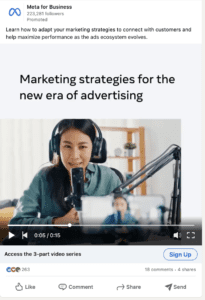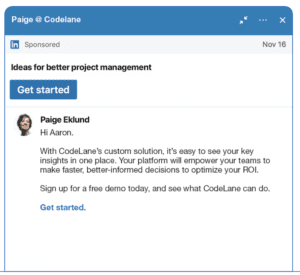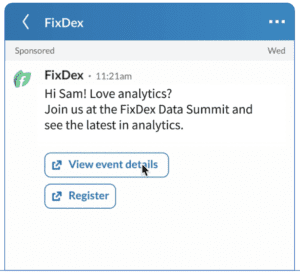Table of Contents
LinkedIn’s simplified 2-click process solidifies the platform as the premier choice for B2B lead generation. The site allows users to click on ads and then directs them to a pre-filled lead form using the information stored on their member profiles. This feature removes the need for users to manually fill in their contact information. Instead, they only have to double-check their info and hit “submit.” Amazing, right?
Related Content:
That, however, leaves advertisers with the harder task: how to get users to click on the ads. To start, it is important to select the correct ad format for your overall campaign goals. LinkedIn offers five lead generation ad formats to choose from:
- Single Image
- Carousel
- Video
- Message
- Conversation
Single Image Ads
Single image ads tend to be the “go-to” ad format here at Go Fish Digital because they show up in the newsfeed and capture the users’ attention as they scroll. We love this format because it looks like a native LinkedIn post but is able to capture user information.
The image has to be a .jpg or .png with ratios either 1.91:1, 1:1, or 1:1.91. Horizontal and square image ads can be served on LinkedIn mobile or desktop, while vertical ads are limited to the mobile platform. Best practice calls for single image ads to be visually stimulating with minimal amounts of on-image text to avoid overwhelming the user with visual clutter. Bonus points if the image is of people – studies show photos of people grab more attention than those without.
Use case: Single image ads are ideal when a client wants the user to download a PDF or case studies, promote events, or even try to capture demos.
Carousel Ads
Carousel ads consist of up to ten images, each with individual links that users can swipe through and explore. This gives advertisers much more room to get creative. For example, marketers utilize carousel ads to capture different images of an infographic or case study that tell a visual story to the user before they submit their information. In this way, carousel ads allow the user to begin interacting with a brand’s content even before navigating to the website. Unlike single image ads, carousel ads can only be square with a 1:1 ratio, but the other best practices still apply.
Use Case: Carousel ads are ideal for displaying product portfolios or telling an interactive story that can unfold as the user swipes through the images.


Video Ads
With video ads, content options are just about limitless. The videos often range from three seconds to 30 minutes, but best practices recommend keeping them concise (under 30 seconds, if possible.) Focus on storytelling and start strong by getting the point across in the first 10 seconds. LinkedIn users do not intend to interact with your content while scrolling, so you must grab their attention quickly or risk losing their interest.
Use Case: Video content is typically more successful in building brand awareness than generating leads. However, here at Go Fish, we still utilize video content for lead generation while recognizing that this format may yield a lower lead form completion rate.
As of July 11, 2022, LinkedIn’s recommended video ad aspect ratio changed from 9:16 to 4:5. Make sure to plan your videos accordingly to avoid LinkedIn adding black bars to the sides of video frames.

Message Ads (previously known as Sponsored InMail)
Message ads are exactly as they sound: direct messages sent to prospects’ LinkedIn inboxes. They consist of a call-to-action button, the body text, and a banner image (only available on desktop). They are sent in real-time and intend to spark immediate action from the user. Like video ads, brevity is best, and the content should focus on the company’s potential value to the user. No one wants to read a long, drawn-out message with no prospective gain for themselves. Message ads can be up to 1,500 characters, but it is recommended to keep it to 500 or less.
Use Case: Message ads are ideal when the goal of the campaign is to reach a very specific audience. It is especially useful when inviting the user to perform one specific action (i.e. download a pdf or attend an event).

Conversation Ads
Like message ads, conversation ads are served directly to LinkedIn members in their inboxes. The difference is that conversation ads aim to start a dialogue with the user by including multiple call-to-action buttons that link to different landing pages or open a Lead Gen Form. Advertisers create prefilled response options for the prospects to choose from and create a message decision tree that guides them through their specific user journey.
Use Case: Conversation ads have similar use cases to message ads, however they offer the option to adapt the offer to each user’s personal journey. It is especially useful when the advertiser has multiple calls to action.

Conclusion
LinkedIn has grown to be so much more than a networking site. In the ever-changing world of online advertising, it stands out as the platform that reaches 65+ million decision makers in the B2B space. Now that you know how to apply LinkedIn ad formats strategically, you can begin serving highly-targeted ads to your organization’s best potential prospects.
Search News Straight To Your Inbox
*Required
Join thousands of marketers to get the best search news in under 5 minutes. Get resources, tips and more with The Splash newsletter:
